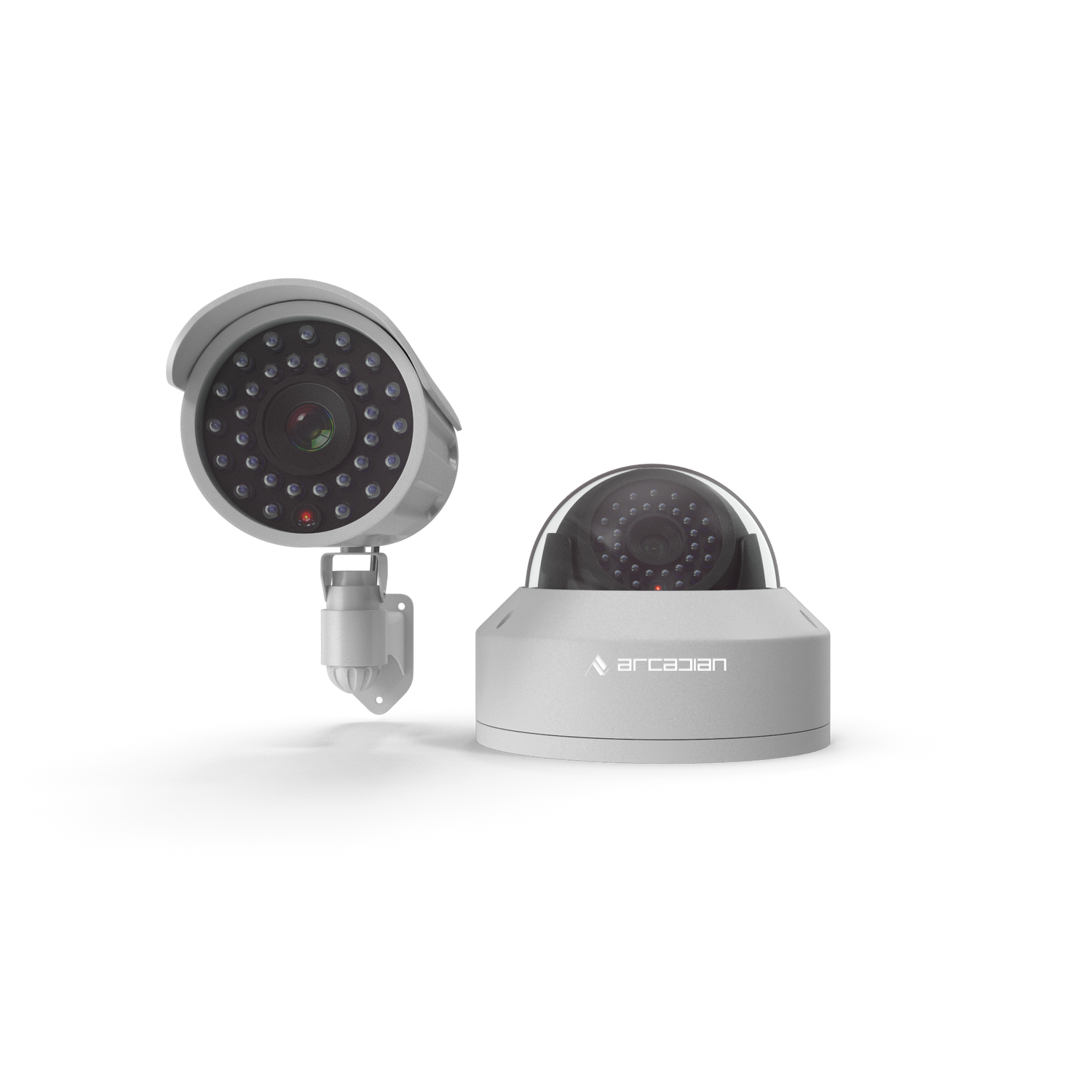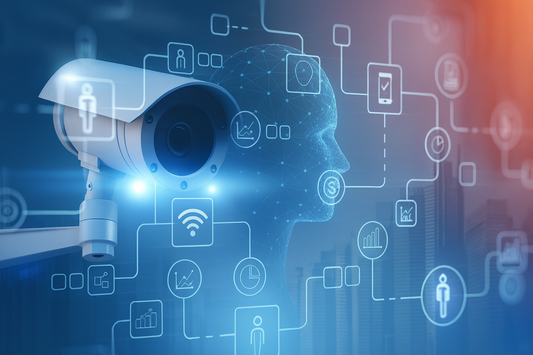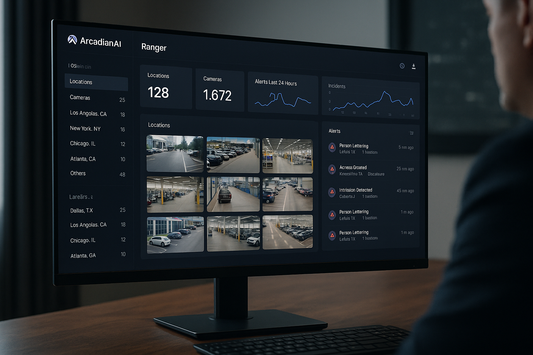Understanding AI in Video Surveillance: From Analytics to Adaptive Intelligence
Not all “AI” in CCTV is intelligent. This blog cuts through marketing hype to explain motion detection, deep learning, and adaptive AI—showing how ArcadianAI transforms false alarms into actionable intelligence.

Introduction
Did you know that 98% of video surveillance “alerts” are false alarms, often triggered by shadows, weather, or insects? Security professionals spend hours chasing ghosts instead of catching real threats. That’s not just inefficient—it’s dangerous. ArcadianAI exists to change this reality. Yet many competitors like Verkada, Eagle Eye Networks, Genetec, and Milestone keep marketing basic motion detection as “AI,” muddying the waters for businesses trying to invest wisely.
The phrase AI in video surveillance has become one of the most overused—and misunderstood—terms in the industry. Too often, what companies sell as “AI” is little more than motion detection wrapped in a glossy interface. Deep learning models get lumped into the same bucket, even though their strengths and limitations differ dramatically. True adaptive AI security, like ArcadianAI’s Ranger, goes beyond static rules and pre-trained models. It learns, adjusts, and responds to the unique conditions of every environment.
In this post, we’ll cut through the hype, explain what AI in CCTV really means, and show why the difference between analytics, deep learning, and adaptive intelligence matters more than ever in 2025.
Quick Summary / Key Takeaways
-
98% of CCTV alerts are false alarms.
-
Motion detection ≠ AI.
-
Deep learning is limited by static training data.
-
Adaptive AI security evolves with context and behavior.
-
ArcadianAI reduces noise and delivers true intelligence.
Background & Relevance
The surveillance industry is experiencing explosive growth. According to MarketsandMarkets (2024), the global video analytics market is projected to reach $22.6 billion by 2028, fueled by AI promises. But the problem is clear: the term “AI” is being abused.
-
Verkada markets “AI-powered alerts” that are little more than human detection triggers.
-
Genetec pushes its Security Center with “intelligent analytics,” but most deployments still rely on static rules.
-
Milestone Systems integrates with third-party “AI,” but struggles with adaptability across diverse environments.
In a world of false claims and false alarms, security leaders must understand what they’re really buying. Businesses cannot afford to confuse marketing buzzwords with real adaptive intelligence.
Core Topic Exploration
What is Motion Detection—and Why It’s Not AI?
Motion detection, the oldest form of “intelligence” in CCTV, works by tracking changes in pixels. A leaf blows across the frame, and suddenly the system thinks there’s a burglar.
Flaws in motion detection:
-
Weather: rain, snow, and wind create endless triggers.
-
Shadows: shifting sunlight confuses static algorithms.
-
Animals: raccoons, birds, and insects trip alarms nightly.
Yet, some brands still label this “AI video analytics.” It’s not AI—it’s guesswork dressed in marketing.
Deep Learning: Smarter, But Still Static
Deep learning introduced object recognition and classification. Instead of just tracking pixel changes, models can recognize people, vehicles, or objects. This is an improvement—but it’s far from perfect.
Limitations of deep learning in CCTV:
-
Models trained in sunny California don’t work in snowy Toronto.
-
A dog might be correctly recognized, but its behavior (threat or not) remains misunderstood.
-
Updating models requires retraining, often costly and time-consuming.
Brands like Eagle Eye Networks and Rhombus Systems push deep learning heavily. While useful for broad detection, it still produces massive volumes of irrelevant alerts.
Adaptive AI Security: Intelligence That Evolves
Adaptive AI, pioneered by ArcadianAI’s Ranger, goes beyond pre-trained models. Instead of treating every scene the same, it adapts to environmental, cultural, and behavioral context.
How adaptive AI works:
-
Learns the difference between regular staff and loiterers at a retail store.
-
Adjusts to seasonal changes: snow in January, outdoor crowds in July.
-
Reduces false alarms by learning “normal” vs. “abnormal” patterns.
In practice, this means:
-
A daycare in Boston gets alerts only when a stranger approaches, not when kids run across the yard.
-
A warehouse in Texas gets notifications when pallets move after hours, not when forklifts operate during shifts.
Adaptive AI transforms surveillance from reactive footage review to proactive risk intelligence.
Comparisons & Use Cases
Table: Motion Detection vs Deep Learning vs Adaptive AI
| Feature | Motion Detection | Deep Learning | Adaptive AI (ArcadianAI) |
|---|---|---|---|
| Trigger Basis | Pixel changes | Pre-trained object classes | Evolving context + behavior |
| False Alarms | Very high | Moderate | Minimal |
| Environmental Awareness | None | Limited | Full adaptation |
| Cost Efficiency | Low upfront, high waste | Mid-range | High ROI |
| Real-World Value | Limited | Narrow | Comprehensive |
ROI Benefits of Adaptive AI
-
Retail: ArcadianAI reduces shrink by up to 35%, compared to 10–15% with basic analytics.
-
Enterprises: Adaptive monitoring saves hundreds of labor hours in false alarm responses.
-
Critical Infrastructure: Lower false dispatches reduce compliance fines and liability risks.
Competitor Comparison
-
Verkada: Attractive interface, but static AI → false positives skyrocket.
-
Genetec: Flexible VMS, but relies on third-party AI → patchwork intelligence.
-
Milestone: Integration-heavy, but lacks built-in adaptability → complexity without clarity.
-
ArcadianAI: Cloud-native, camera-agnostic, adaptive intelligence → actionable security insights.
Common Questions (FAQ)
Q1: Is motion detection the same as AI?
No. Motion detection is a rule-based system, not intelligence.
Q2: Why do deep learning systems still generate false alarms?
Because they rely on static training data that doesn’t adjust to context.
Q3: What makes adaptive AI different?
It evolves based on patterns, behaviors, and environmental context unique to each site.
Q4: Can ArcadianAI work with existing cameras?
Yes, it’s camera-agnostic, meaning it integrates with Axis, Hanwha, Hikvision, and more.
Q5: How does adaptive AI reduce costs?
By cutting false alarms, saving labor hours, and preventing unnecessary guard dispatches.
Conclusion & CTA
The industry loves to throw around “AI” as a buzzword, but not all AI is created equal. Motion detection is outdated. Deep learning is useful but static. Only adaptive AI security—like ArcadianAI’s Ranger—can deliver true intelligence, reducing false alarms and protecting people in real time.
If your current system is drowning in noise, it’s time to rethink your investment. Don’t buy marketing hype—demand real intelligence.
👉 See ArcadianAI in Action → Get Demo – ArcadianAI
Security Glossary (2025 Edition)
Adaptive AI Security — AI that evolves with environmental and behavioral context to reduce false alarms.
AI Video Analytics — Automated analysis of video footage using algorithms to detect objects, patterns, or anomalies.
CCTV (Closed-Circuit Television) — Video surveillance system using cameras connected to monitors or recorders.
Deep Learning — Machine learning technique that uses neural networks to classify objects and patterns.
False Alarm Reduction — The process of minimizing irrelevant alerts in video surveillance.
Genetec — Security software provider known for its VMS platform, Security Center.
Milestone Systems — Danish company offering VMS solutions with third-party AI integrations.
Motion Detection — Basic video analytics method based on pixel changes, often mistaken for AI.
NVR (Network Video Recorder) — Device that records and stores video footage from IP cameras.
Ranger — ArcadianAI’s adaptive AI assistant for real-time surveillance intelligence.
Retail Shrink — Loss of inventory from theft, fraud, or errors.
Static AI — AI models that cannot adjust dynamically to changing environments.
Surveillance ROI — The financial return from investing in video surveillance technologies.
Verkada — Cloud-based surveillance vendor marketing AI-powered cameras.
Video Management System (VMS) — Software that manages video feeds, recording, and playback.
VSaaS (Video Surveillance as a Service) — Cloud-based surveillance model with storage, analytics, and management.

Security is like insurance—until you need it, you don’t think about it.
But when something goes wrong? Break-ins, theft, liability claims—suddenly, it’s all you think about.
ArcadianAI upgrades your security to the AI era—no new hardware, no sky-high costs, just smart protection that works.
→ Stop security incidents before they happen
→ Cut security costs without cutting corners
→ Run your business without the worry
Because the best security isn’t reactive—it’s proactive.







